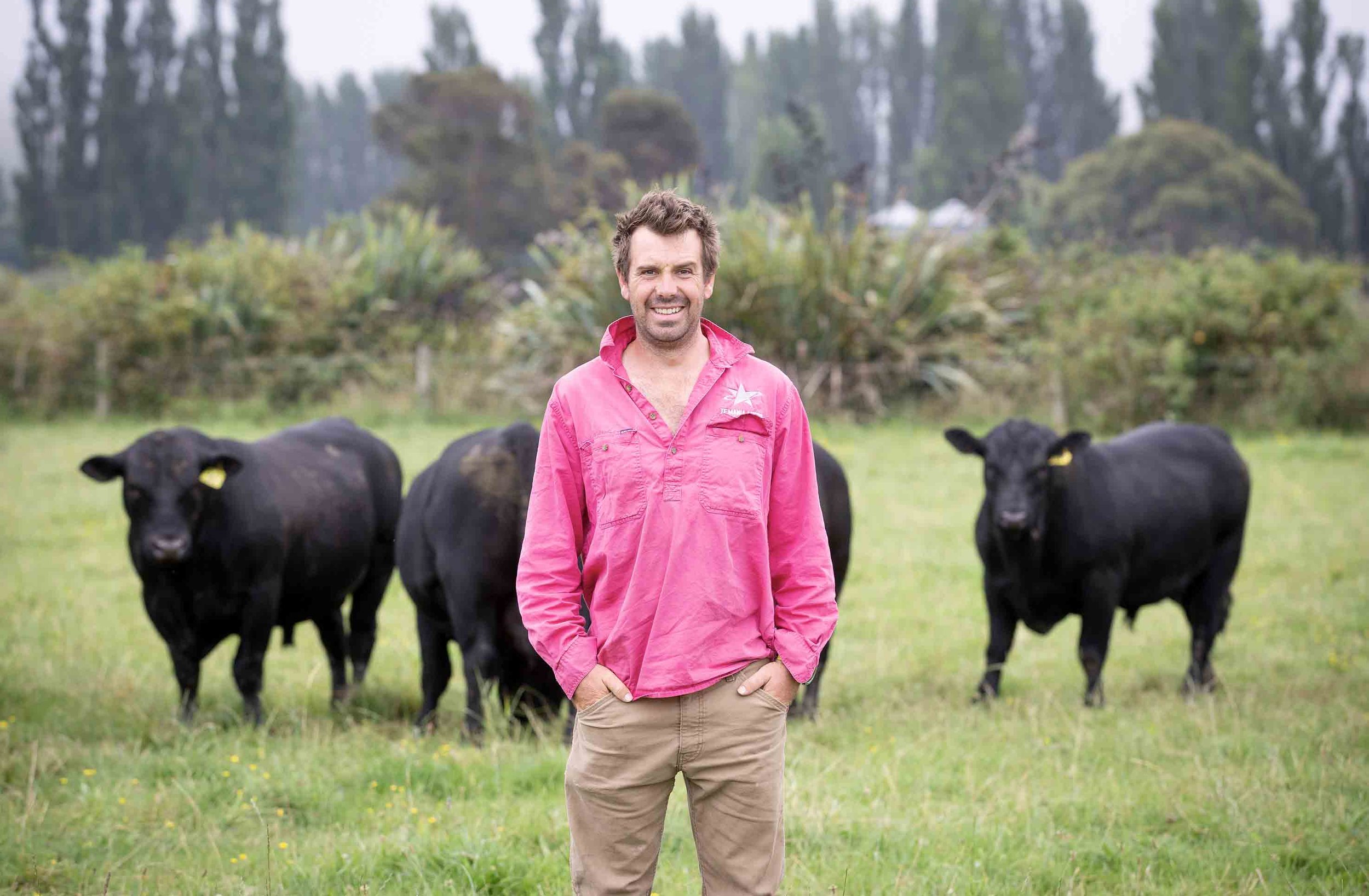
An efficient path to Profitability
Article written and photographed by Sarah Horrocks — AngusPRO Magazine 2023
It was a bold move for 24-year-old Will Wilding to ditch his job in Canada’s oil fields and move home to the family farm. He was tasked with taking on a different kind of black gold ‒ the four-legged, fast growing and well-eating kind that roams the rugged hills of Te Mania in Conway Flat, North Canterbury.
Will was the stock manager back in 2014, working under the guidance of the late Lindsay Haugh. The stud was very similar then to what it looks like now, with a lot of technology and commercial farming practices in use, however, Will’s innovative mind wouldn’t rest and he was determined to take things to a new level.
Te Mania is one of the oldest and largest studs in New Zealand, with more than 90 years of history, experience and innovation. The Wilding family and their cattle moved to Conway Flat in North Canterbury back in 1934 and it was Will’s grandfather Frank Wilding who set the herd on a path of high performance and productivity.
As the first herd in the country to weigh cattle on scales, record animals with BREEDPLAN and mate yearling heifers back in the 1970s, breaking new ground is not unfamiliar territory. So when overseas investor Thomas Grothe came on board in November 2021 the team wasted no time getting to work on a new feed efficiency project.
Will says when Thomas first began discussions with the Wilding family, he was particularly interested to talk about improving feed efficiency, for both its economic and environmental benefits.
“I had heard about the reputation of Te Mania’s cattle and I wanted to be part of it. I wanted to enable them to take further steps with my financial backing,” Thomas says.
Will believes that methane is going to be the next big issue for farmers and there is research to show that that dry matter intake and methane emissions are highly correlated at 0.83. Producing more beef with less feed will pay dividends to the industry’s bottom line since it’s arguably the single most valuable trait in beef production.
One of the first partnerships that were forged when Thomas came on board was with Vytelle, a global precision livestock company focused on reshaping the industry and fast-forwarding genetic progress. Vytelle Sense is a research feed-pad technology that identifies the most efficient animals with an individual animal feed intake and weight-gain data-capture system.
Animals are run through a feed pad in groups of 25‒40 for 70 days while the Vytelle technology weighs their feed intake from the bins using EID ear tag technology and collects individual animal weights when they have a drink.
Vytelle claims that genetic selection for feed efficiency will reduce feed intake by up to 12%, reduce methane production by 30%, and improve profitability.
Thomas says, “If we can increase feed efficiency, and consequently decrease methane emissions, then I think we are taking farming in the right direction. These claims need to be proven and I’m willing to invest in trials to prove they are accurate.”
The research unit at Te Mania was finished by September 2022 and the yearling bulls were the first to cycle through it. Animal welfare is a top priority, with pea gravel over a sand dune base and plenty of shade and shelter under established trees.
The bulls are divided into four pens from within each contemporary group and lucerne silage is fed in the feed bins. The raw phenotypic data collected is continuously monitored and collated by Vytelle in Canada and delivered back as an EPD (America’s version of an EBV). Ultimately this information increases the accuracy of the net feed intake (NFI) EBVs available on Te Mania’s animals, and it also has wider industry good, as the NFI EBVs of related animals that are registered with Angus Australia are also improved for accuracy.
After the bulls have completed their time in the unit, the heifer calves will go through. This information is used alongside all other breeding tools to help select the highest performing females for flushing.
“If we can identify and breed from genetic profiles that are better for the environment, we can reduce our environmental footprint in a greater way,” Will says.
He says that embryo transplant (ET) will allow Te Mania to flush the most feed-efficient females in the herd, and after sourcing semen from the most feed-efficient sires they’ll be able to generate a refined bloodline that has reduced methane emissions, which will have appeal to the end consumer. The commercial farmer will be interested too of course, as the positive effect on profitability is a certainty. Vytelle claims that a 10% improvement in feed efficiency can lead to a 43% improvement in profit.
As the newly named managing director of Te Mania, Will is not just focused on feed efficiency, but also on the unchanged core values of the stud. Maternal qualities are first and foremost – a cow that gets in calf every year, calves easily, rears that calf and then repeats this every year thereafter.
Te Mania totals 2200ha and calves 550 mixed age cows (including 50 ET recipients), as well as putting 250 yearling heifers through artificial insemination (AI) annually. Every female at Te Mania goes through AI except the two-year-old yearling heifers with calves at foot, who are run with the top end of the home-bred yearling bulls.
Mating yearling heifers is of high importance as a selection pressure,” says Will.
Everything is run in large contemporary mobs to keep commercial pressure on and keep results realistic in the commercial environment. The cows are out on the hills through winter and are only brought down for calving to enable the team to collect birth weights.
“We try to run the same number of stock units here that a commercial farmer would.”
The only non-commercial feeding practice is when the sale bulls are supplemented with fodder beet after their 600 day weights are collected since the market demands that the bulls are presented well for sale day.
“We want to ensure those 600 day weights are accurate in the commercial environment.”
All the young stock (250-odd heifers and 250-odd bulls) spend their first winter at One Tree Hill, a 900ha block purchased by Thomas in 2022 and leased back to Te Mania Livestock Ltd. The block is a mere 20 minutes away from the main farm and has the capacity for an additional 600 commercial calves and 450 R2 steers. Ultimately Will wants to be buying these back from his clients, but this is proving difficult with the number required.Steers are purchased in the spring and stay on One Tree Hill through the summer. They’re then brought down to Te Mania in March to be finished on grass, fodder beet and lucerne balage before being processed through Alliance’s Handpicked programme in June/July.
The steers killed in 2022 had mixed results according to Will.
“We noticed big differences in the trade steers.”
Animals bought in from his clients hit the $1 Handpicked premiums, with marble scores of up to +7. However, the steers that were bought in from elsewhere had mixed results, often hitting the weight grades but still only having marble scores of zero to +1 and therefore not meeting Handpicked’s targets.
“It’s frustrating when a beast is prime and up to weight, yet still not marbling.”
Marbling is a trait that Will is starting to put more and more emphasis on while maintaining the basic principles of the herd. In 2022 he used Lawsons Rocky within the AI programme and is excited to see the impact that his intramuscular fats will have on the Te Mania herd.
AI is done in November with follow-up bulls run until the first or second week of January ‒ two cycles. Calving starts in August, with the heifers starting two weeks earlier than the MA cows, purely for ease of management.
Staff demands at this time of year are high and keep the team – a block manager and general at One Tree Hill and a stock manager and general at Te Mania — pretty busy. Will oversees the entire farming operation and while Thomas spends only a few months of the year at Te Mania, he certainly isn’t afraid to get his hands dirty, often putting his hand up for some of the less desirable tasks.
Of course, as well as the 250 heifers born every year, there are the same number of bull calves. These are all taken through, with 40 bulls sold as yearlings in October and the cream of the crop retained to use as chaser bulls after AI.
“The yearling sale bulls are selected solely for heifer mating,” Will says.
The following June, 140 are catalogued for the two-year-old sale. Will is looking to increase the total number of bulls bred, but the excess will be sold by private contract sale, rather than increasing the number of bulls auctioned in June.
“The most consistent feedback we get is how balanced our EBVs are.”
While the bulls may not be at the top of the pile for marbling, growth or other individual EBV traits, they have excellent balance within the right traits. So, when their figures are combined, they come out with high selection index figures in the $PRO and $A index, which shows their high all-around balance and performance.
“As a catalogue average, we usually index in the top 10%.”
The Te Mania herd are genuine hill country cows, living in the hills for more time than they do on the flats.
“Our core philosophy hasn’t changed, but new technologies are allowing us to select and make breeding decisions on a whole new playing field,” Will says.
Net Feed Intake Explained
Cattle of all breeds eat variable amounts each day, some more, some less than their counterparts, while gaining the same weight. This is due to each animal’s net feed intake (NFI) or the difference between an animal’s actual feed intake and predicted feed intake, for a given level of production.
NFI is a moderately heritable trait; therefore it can be used in parallel with other performance selection criteria and will be passed on to progeny with confidence.
Selecting for low, or desirable, NFI won’t affect frame size, growth, or carcass quality in any breeds, making it a risk-free factor in genetic selection.





